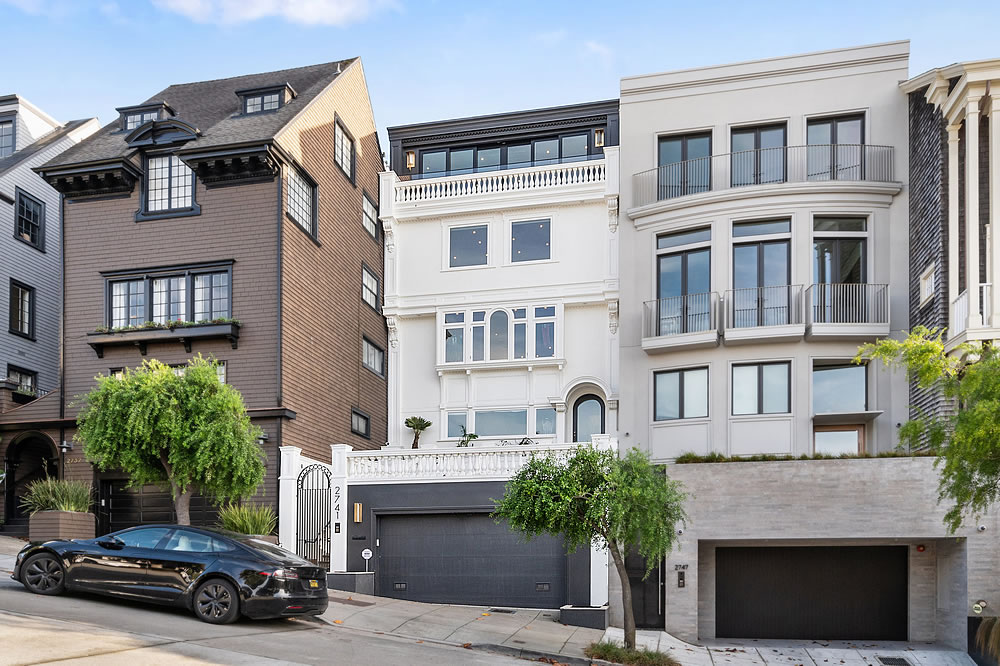Purchased for $9.500 million in March of 2020, the four-level, five-bedroom Pacific Heights home at 2741 Vallejo Street, “an exclusive and quiet street surrounded by lovely homes and a short distance to the Presidio,” returned to the market priced at $9.995 million three months ago.
Featuring an “updated floor plan,” with “the scale you would expect of a grand Pac Heights home,” marble galore, a terraced rear yard and putting green, and some big Bay views, the list price for the 4,300-square-foot home, not including its two-car garage, has just been reduced to $8.750 million, a sale at which would be considered to be “at asking” according to all industry stats and aggregate reports but would be down 8 percent on an apples-to-apples basis from the first quarter of 2020 and $50,000 less than the home fetched in September of 2016, prior to it being updated and modernized.
If you think you know the market for updated homes in “sought-after Pacific Heights!” and other long-established neighborhoods, now’s the time to tell.









There is no color scheme like the modern farmhouse color scheme. I like the Scandinavian wood panels here and there, even if they don’t really go with the rest of the architecture.
People with any sense ride bikes or go in the ocean now, instead of playing golf. The putting green backyard seems out of place.
I guess 4,300sf * $1,800 psf = $7,740,000
The WSJ prime rate is 8.5%. 30Y mortgage rates are 6.6%.
“Oh but you peasant, rich people pay cash for these houses.” Sure enough, but if you decided to purchase this house for $10mm in June of 2021, when 5-year treasury bonds were yielding .77%, you would have been giving up $77,000 in treasury income per year.
Now, if you pay up 7.8mm to buy this house when 5 year treasury bonds are yielding 3.8%, you are giving up (7,800,000 * .038) = $296,400 in income per year, nearly 4 times the income opportunity cost of using that money to buy a nice house.
This property has open an enforcement case and active violation with the City (NOV #202311716). Most of their recent permits expired, so this “updated floor plan” was likely completed without required review and inspections. The top roof deck is also a death trap because it has no railings.
Oy. It appears that a first notice of violation was issued back in the Fall of 2021. The case update from this past summer (“Residence/Dwelling WORK BEYOND SCOPE OF PERMIT; OTHER ELECTRICAL; OTHER PLUMBING;”) mentions “A) need to obtain new permits [required] to complete finishes & show final [plumbing] inspections. B) obtain addition mechanical permit for the multiple heat pumps – mini split systems installed. WWOP. Open walls / expose piping as may be rqrd for these inspections.” Around the same time frame, Complaint Number: 202028531 mentions sewer leaks/seepage and work done under expired permits.
From 2021, Complaint Number: 202181540 is described as “Residence/Dwelling WORK BEYOND SCOPE OF PERMIT…tearing off and expanding back of house; HVAC units on top of roof; no permits for skylights”.
Wow, for $10m, or $9m, I would expect some effort to stage the home. They didn’t bother emptying the kitchen sink, there’s a smoke detector dangling from the ceiling in the game room, and the master bedroom has a freestanding rack of clothes in a corner!
This house looks like it was redesigned by a tech bro who never imagined having children. You have your putting green and your bar to entertain your friends and a backyard, not for playing but for entertaining adults. It seems like the wrong neighborhood and wrong house for all that. It’s a lovely, sleepy street and not near the sort of entertainment a young master of the universe would look for.
Childless people are allowed to buy property anywhere they like.
How has this loophole escaped the State
busybodiesLegislature’s correction ??The miniature (golf) course is kinda’ cute…conceptually, at least, since it doesn’t have anything like a meaningful number of holes. But cute isn’t worth 8 figures.
A certain Lebowski quote comes to mind 😉 It’s a putting green, not a mini-golf course.
I don’t think I know the market for updated homes in “sought-after Pacific Heights!” but I do think that this will trade for six figures less than what it fetched prior to it being “updated and modernized” (see the above comment by Claire). Will the contractors that did the work on this have to warranty any of their work after the home becomes the responsibility of a new buyer who purchased it in what I would guess the purchase contract will specify as an “as is” condition?
This probably won’t close at all in the next sixty days, but if it does, that transaction’s price won’t have much to say about the direction of the market for grand Pacific Heights homes as much as it will the idiosyncratic risk a buyer will have to swallow with this half-baked project.
You can see the “budget architectural work” in the stair railing on the landing in photo 3/35 (numbering in the upper left when you hover over the photo) of the website. Note how someone mismeasured, and the railing at the landing dips down as it connects to the railing along the wall? The whole railing mismatch looks like it was caused by some sort of last minute lowering of the railing on the wall, to prevent the railing along the wall from blocking the light switch behind it more than it already does, giving the two sections of lower railing more of an Escher Diagram quality. On a $9M property!
If this house had been carefully restored rather than destroyed, it might well be worth the original price. At what point will the flippers understand that outer Vallejo (and many other parts of northern SF) is appealing to traditional people who like traditional SF homes?
I would love to see what it looked like before it was destroyed. I’m all for updating but this house is an absolute mess and every little bit of charm is gone. Surely the backyard could have been made more inviting, the kitchen doesn’t seem to be particularly user friendly and there’s just no warmth anywhere.
Compass has an old picture of the facade. This BTW shows how the adjacent property was brutalized even more.
I found a Nina Hatvany video from 2016. The house was beautiful and didn’t need a thing. The house next door was lovely too. Why do people do things like this to these old, grand houses?
Because houses are made for living in, and most people don’t want to live in Victorian museum.
That’s what real estate agents, flippers and the other hangers-on in the S.F. real estate “game” say when they want to defend the practice. They say that following white box trends sells, the implication being that it will sell for more than a restored traditional house would. But in this case, the “modernization” is going to lose the flipper money (before accounting for leverage).
The house next door was built in 1995 and prior to that it was an empty lot.
Though I agree, the remodels are a decline.
Please don’t take this personally, but I hate you for finding that video….forvever!
🙂
No, seriously, despite what you inferred – and Kyle came right out and claimed – this clearly wasn’t some museum exhibit on “House design in the Early 20th Century”: it was an older (1907) house that was updated to modern standards. I guess there are people who like what’s there now to what was there before – and most of them will need the house further modified so it’s safe for the legally blind – but it’s hard to believe the former so ounumber the latter as to have made this worthwhile.
What was done in the backyard is a crime against
humanitybotany…too bad the UN is too busy with other things to take this case.Golf dork, tequila drinker with bad a filing system. Other than that zero charm to this one. Low $8mm value.
The pictures for 2747 Vallejo are still on line. My question is – this was a relatively new house, done beautifully in a certain style with obviously high end finishes. Who looks at a house like that and thinks “I’m going to gut all this and completely redo it in a totally different style.” Looking at the pictures of 2741 it would never occur to me to buy it and add all the features that would turn it back into a classic house. I’d buy another house that would fit my esthetic.
It would be interesting to see what this house looked like as built. Normally the odds for that would seem slim, but in this case it was
ownedinhabited by a member of a prominent family, Ghirardelli – which you might recall also figured in a Piedmont property on here a while back (sometimes spelled correctly, and sometimes not) – so it’s not entirely impossible that something might turn up.I don’t think anyone even lives in Pacific Heights or Cow Hollow anymore. How could they? It’s block after block of old houses being gut-remodeled by high-end flippers and 23-year-old techlords. The flippers cut and run as soon as they sell and the techlords never even live there a year before selling to the next tech techlord/vulture capitalist who starts the whole demolition process started again. It’s the most flagrant waste of energy that I can imagine. I feel badly for the handful of oldtimers who have to live with the constant racket of bobcats, dumptrucks, and pneumatic drills.
“It’s the most flagrant waste of energy that I can imagine”
That’s apt of anything techlords touch. Crypto, AI, robot cars, etc.– grifts that waste the equivalent energy of mid-sized industrial nations, propelling the world faster towards climate change, immiseration, and dystopia.
You are aware that you are writing this on the internet, right?
And there is the deviously clever and completely unexpected tu quoque barb, one of the weakest tools in the logical fallacy arsenal.
A curious person might use the internet to learn why, how, and by whom the internet was created, and who paid for it (hint: the techlords had nothing to do with it). And while the internet became rapidly more useful after its public launch, its “user-friendliness” peaked well over a decade ago and has been deteriorating since. You can learn more about the decline of the internet by typing in “Cory Doctorow’s neologism” into the search engine of your choice. And while the techlords had nothing to do with the creation of the internet, they are directly culpable for its deterioration, as Doctorow documents.
🙂
Thank goodness someone is keeping track of who are the good techlords and who are the bad techlords.
I never implied there are any good techlords! 🤣
#logic 👍
UPDATE: Modernized Pac Heights Pad Still Available for Millions Less